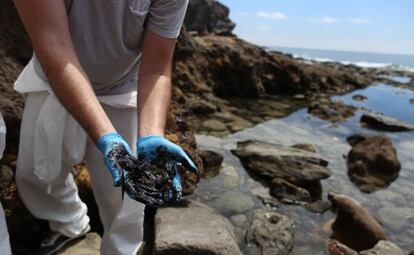Government unaware of how much fuel has leaked from Canaries wreck
Tenerife on alert due to risk to coast, but ministry insists no new slicks have been located Authorities say they have cleaned up 400 kilos of fuel oil from the sunken trawler so far


Two weeks after the start of a crisis involving the Oleg Naydenov Russian trawler – which caught fire and was towed off the coast of the Canary Islands, where it sank – and there is still no end in sight. The Spanish government does not know the amount of fuel oil that has so far seeped out from the tanks of the boat, which was carrying more than 1,400 tons in total, but which is now resting on the sea bed at a depth of 2,710 meters, 24 kilometers off the coast of Gran Canaria.
The secretary of state for the Public Works Ministry, Julio Gómez Pomar, admitted on Sunday that fuel oil is still leaking from the fishing boat, adding that it is very hard to work out the amount that is already in the sea. Gómez explained that, since the beginning of the crisis, just 400 kilos of hydrocarbons have been recovered. The main job for the coastguard ships that are in the area so far is to disperse the slicks that are threatening to wash up on the coast of the islands.
The main job for the coastguard is to disperse the slicks that are threatening to wash up on the coast of the islands
The alarm was raised on Saturday, when the Canarian government announced that an oil slick was located just a few miles of the south of Tenerife, only to later rectify that news. Since then, the secretary of state has explained that, until now, no fuel oil has been spotted in that area. News of that “false alarm” was also confirmed by the Canarian economy, tax and security chief, Javier González.
However, emergency protocols are still in effect in Tenerife. According to González, prediction models for the currents suggest that this area and the coast of La Gomera are “susceptible” to the arrival of the fuel oil at any moment. Given the winds and the currents, explained the Public Works Ministry secretary, the channel between Gran Canaria and Tenerife is being carefully monitored.
So far, only small lumps of fuel oil have washed up on the west coast of Gran Canaria. The administrations in the area claim that the five beaches that have been affected have already been cleaned up.
Reconnaissance flights in the area turned up a small oil slick on Sunday to the west of the area where the Russian trawler sank, measuring around 500 to 700 meters. What’s more, there is careful monitoring of the biggest slick, which, since the start of the crisis, is located to the south of the islands.
The ministry is planning to seal up the leaks that have been detected in the shipwreck. But that work is yet to start, as Gómez Pomar admitted. For now, the submarines that have been hired by the ministry have located three cracks from which fuel is leaking, although there may be more.
The secretary of state and the Canarian economy chief took part in a coordination meeting for the emergency plan that has been in place since the ship ran into difficulties in the port of Las Palmas.
The administrations in the area claim that the five beaches that have been affected have already been cleaned up
The port of Las Palmas is the biggest maritime refuelling station in Spain. Every year, around two million tons of fuel oil are served up there. The day that the Oleg Naydenov began to burn, the tanks were already full, given that the ship was due to set sail that same afternoon. The Spanish authorities took the decision at that point to send it out to sea, where it ended up sinking after three days.
The handling of the case, particularly the decision to tow the trawler out to sea, has been widely criticized and has drawn comparisons with the Prestige, an oil tanker that sank off Galicia in 2002 with catastrophic consequences.
Environmental group Greenpeace has asked the minister to specify how the government plans to “extract the fuel from the fishing vessel’s tanks.” The group is concerned that the tanks might break up altogether and leak out their content, and has called for an investigation into the decision to “take a ship that was at port out to open seas, and subject it to an erratic and unnecessary course in an area with high environmental value.”
Tu suscripción se está usando en otro dispositivo
¿Quieres añadir otro usuario a tu suscripción?
Si continúas leyendo en este dispositivo, no se podrá leer en el otro.
FlechaTu suscripción se está usando en otro dispositivo y solo puedes acceder a EL PAÍS desde un dispositivo a la vez.
Si quieres compartir tu cuenta, cambia tu suscripción a la modalidad Premium, así podrás añadir otro usuario. Cada uno accederá con su propia cuenta de email, lo que os permitirá personalizar vuestra experiencia en EL PAÍS.
¿Tienes una suscripción de empresa? Accede aquí para contratar más cuentas.
En el caso de no saber quién está usando tu cuenta, te recomendamos cambiar tu contraseña aquí.
Si decides continuar compartiendo tu cuenta, este mensaje se mostrará en tu dispositivo y en el de la otra persona que está usando tu cuenta de forma indefinida, afectando a tu experiencia de lectura. Puedes consultar aquí los términos y condiciones de la suscripción digital.
More information

Fuel oil reaches coast of Gran Canaria
Últimas noticias
The complicated life of Francesca Albanese: A rising figure in Italy but barred from every bank by Trump’s sanctions
Half of Scotland is in the hands of 420 property owners
Pinochet’s victims grapple with José Antonio Kast’s rise in Chile
Reinhard Genzel, Nobel laureate in physics: ‘One-minute videos will never give you the truth’
Most viewed
- Pablo Escobar’s hippos: A serious environmental problem, 40 years on
- Why we lost the habit of sleeping in two segments and how that changed our sense of time
- Charles Dubouloz, mountaineering star, retires at 36 with a farewell tour inspired by Walter Bonatti
- Reinhard Genzel, Nobel laureate in physics: ‘One-minute videos will never give you the truth’
- The Florida Keys tourist paradise is besieged by immigration agents: ‘We’ve never seen anything like this’








































